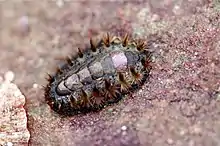Acanthochitona garnoti
Acanthochitona garnoti, the spiny chiton, is a medium-sized polyplacophoran mollusc in the family Acanthochitonidae,[1] found on the coast of southern Africa.
| Acanthochitona garnoti | |
|---|---|
 | |
| Scientific classification | |
| Kingdom: | Animalia |
| Phylum: | Mollusca |
| Class: | Polyplacophora |
| Order: | Chitonida |
| Family: | Acanthochitonidae |
| Genus: | Acanthochitona |
| Species: | A. garnoti |
| Binomial name | |
| Acanthochitona garnoti (Blainville, 1825) | |
| Synonyms | |
| |
Description
This species is conspicuous for the nine paired tufts or rosettes of long glassy spines that decorate its girdle. Between the tufts, the girdle bears many smaller spicules. The valves are of a dull brown color and marked with oblique pale stripes. They are largely concealed by the girdle. Adult size is 30–45 mm.[2]
Distribution and habitat
A. garnoti occurs along the south coast of Africa, from Cape Columbine in Namibia to the south coast of KwaZulu-Natal in South Africa. It can be found on exposed rock surfaces high up in the inter-tidal zone, a location that is unusually far from the water for chitons.[2]
Ecology
The species is mostly active at night, foraging by grazing in a small radius (10–30 cm) around its location. Both the range and the pattern of foraging are adapted to the type of substrate, with different strategies adopted on rocky versus sandy ground.[3]
References
- E. Schwabe (2015). "Acanthochitona garnoti". WoRMS. World Register of Marine Species. Retrieved 28 December 2016.
- Branch, G. M.; Griffiths, C. L.; Branch, M. L. & Beckley, L. E. (2010). Two Oceans: a Guide to the Marine Life of Southern Africa. Cape Town: Struik Nature.
- Cretchley, R.; Hodgson, A.N.; Gray, D.R. & Reddy, K. (1997). "Variation in foraging activity of Acanthochitona garnoti (Mollusca: Polyplacophora) from different habitats". South African Journal of Zoology. 32 (3): 59–63. doi:10.1080/02541858.1997.11448431.